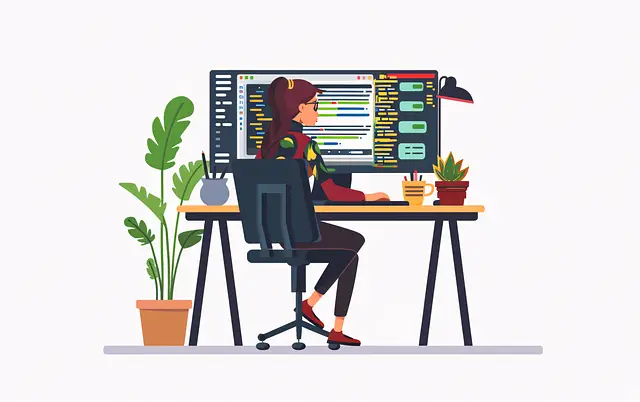
Imagine telling your computer what you want to build—in plain English—and watching as it writes all the code for you. No programming languages to learn, no syntax errors to debugging, just describing your vision and seeing it come to life. This revolutionary approach, known as “vibe coding,” transforms how software gets created in 2025, making development accessible to everyone from seasoned programmers to creative professionals with zero coding experience.
Table of Contents
ToggleWhat Is Vibe Coding?
Vibe coding is an AI-dependent programming technique where people describe problems in natural language and artificial intelligence generates the code. Coined by renowned AI expert Andrej Karpathy in February 2025, the term quickly gained traction and was added to the Merriam-Webster Dictionary by March as a “slang & trending” term.
Rather than writing code line by line, vibe coding shifts the programmer’s role to that of a director—guiding, testing, and refining AI-generated code. It’s like having a tireless coding assistant who handles all the technical details while you focus on the creative vision.
As Karpathy himself described it: “It’s not really coding – I just see things, say things, run things and copy-paste things, and it mostly works.” This casual approach—focusing on the “vibe” or general intention rather than precise implementation—gives the technique its name.
The Core Principles of Vibe Coding
At its heart, vibe coding represents a fundamental shift in how we approach software creation:
1.Natural Language Prompting
Instead of writing code, developers express desired features in everyday language. For example, saying “Create a React app with a login form and a dark mode toggle” is enough to generate functional code. This makes the barrier to entry dramatically lower for non-technical creators.
2.AI as Your Coding Partner
The AI functions as a collaborative partner rather than just a tool. You describe what you want, the AI writes the code, and you guide the process through conversation. The developer becomes more of a director who directs and orchestrates what needs to be done rather than implementing every detail manually.
3. Embracing Iteration Over Perfection
Vibe coding prioritizes speed and rapid iteration. If something doesn’t work, rather than spending hours debugging, developers often simply regenerate the code or ask for modifications until it works correctly.
How Vibe Coding Works in Practice
Unlike traditional coding, which requires detailed technical knowledge, vibe coding follows a more intuitive approach:
- Describe Your Goal: Start by describing what you want to create in everyday language.
- AI Generates the Code: An AI tool interprets your request and produces the necessary code almost instantly.
- Review and Refine Through Conversation: If the result isn’t exactly what you envisioned, simply tell the AI what needs changing, as you would with a colleague.
- Test and Deploy: Once satisfied, test the application and deploy it. If errors occur, you can copy and paste the error messages to the AI, which will suggest fixes.
Many vibe coding practitioners, including Karpathy, use voice commands rather than typing. “I just talk to Composer with SuperWhisper so I barely even touch the keyboard,” Karpathy noted about his workflow.
Some Examples of Tools Powering the Vibe Coding Revolution
Several AI-powered tools have emerged to facilitate this new approach:
1.Cursor Composer
Frequently mentioned by Karpathy, Cursor Composer with its Sonnet model appears to be a leading tool for vibe coding. It not only generates code but can also autonomously iterate, lint, and run tests.
2.GitHub Copilot
While originally designed as a code-completion tool, GitHub Copilot has evolved to support more conversational coding approaches. By mid-2023, it was already the most admired AI development tool in Stack Overflow’s survey.
3.ChatGPT and AI Chatbots
General-purpose AI chatbots like OpenAI’s ChatGPT (especially with GPT-4) have become surprisingly effective vibe coding tools. Their ability to understand natural language queries makes them powerful assistants for coding tasks, even for those with zero programming background.
4.Replit Agent
Replit’s AI agent enables users to build and deploy applications through chat. In 2025, they launched a mobile app creation agent where users can text or voice-message their app idea and have the AI build and deploy it.
Real-World Applications
Vibe coding is proving particularly valuable for:
1.Rapid Prototyping
Entrepreneurs and product managers can quickly transform ideas into working prototypes without needing a development team. What previously took weeks can now be accomplished in hours.
2.Creative Projects

Artists and designers with limited coding experience can now bring interactive digital installations to life simply by describing their vision.
3.Small Business Websites and Apps

Local businesses can create custom web applications tailored to their specific needs without hiring expensive development agencies.
4.Personal Projects
Weekend hobbyists can build functional applications without getting bogged down in technical details. As Karpathy noted, it’s “not too bad for throwaway weekend projects”.
The Benefits and Limitations
Benefits:
- Democratized Development: People without formal programming training can now create software.
- Exponential Speed: Development cycles are dramatically shortened, with “exponential productivity gains measured in orders of magnitude”.
- Focus on Vision: Creators can concentrate on what they want to build rather than how to build it.
- Reduced Technical Barriers: The technical complexity is handled by AI, removing barriers to entry.
Limitations:
- Comprehension Challenges: As Karpathy noted, “The code grows beyond my usual comprehension, I’d have to really read through it for a while. This can make maintenance difficult”.
- Debugging Limitations: When the AI can’t fix a bug, users might resort to workarounds rather than systematic debugging. Karpathy admits that sometimes “asking for random changes until it goes away”.
- Dependency on AI Tools: Relying heavily on AI tools creates a new kind of dependency that may raise concerns for some projects.
Not Suitable for All Projects: Mission-critical applications requiring meticulous control may not be appropriate for vibe coding.
Industry Adoption
Vibe coding is rapidly gaining traction among tech professionals. Y Combinator executives have called it the “dominant way to code,” with Garry Tan stating: “This isn’t a fad. This isn’t going away. This is the dominant way to code, and if you’re not doing it, you might be left behind.”
Even technology giants like Google appear to be embracing this approach, with indications it might influence how they develop search algorithms in the future.
Getting Started with Vibe Coding
If you’re intrigued and want to try it yourself:
- Choose a Tool: Start with user-friendly options like ChatGPT, Cursor, or Replit’s platform.
- Start Simple: Begin with small projects to get comfortable with the interaction style.
- Learn to Ask: Develop skills in clearly describing what you want—this is the new “programming language.”
- Iterate Quickly: Don’t spend too long perfecting a prompt; it’s often faster to see what the AI produces and then refine it.
- Test Thoroughly: While the AI handles the coding, you’re still responsible for ensuring the final product works correctly.
Future Implications
Vibe coding represents a fundamental shift in software creation, with potential long-term impacts:
- New Creative Roles: Positions like “AI Prompt Engineer” may emerge as specializations.
- Education Changes: Programming education might shift toward teaching effective collaboration with AI rather than traditional coding syntax.
- Accelerated Innovation: As the barrier to creating software drops, we may see an explosion of individuals who will develop niche applications that will serve previously underserved markets.
- Changed Relationship with Code: Our fundamental relationship with technology creation is evolving, emphasizing intent over implementation.
Conclusion
Vibe coding marks a significant turning point in how we create software. By making development accessible to nearly anyone who can clearly articulate their vision, it promises to unleash a new wave of digital creativity and innovation.
While traditional coding skills remain valuable, vibe coding opens doors for countless creative professionals who previously couldn’t translate their ideas into functional software. Whether you’re a professional developer looking to accelerate your workflow or a creative with no coding background but plenty of ideas, vibe coding offers an exciting new approach to bringing digital projects to life.
FAQs Related to Vibe Coding
What exactly is vibe coding?
Vibe coding is an AI-dependent programming approach where you describe what you want in natural language, and AI tools generate the actual code for you. It shifts the focus from writing code to describing your vision.
Do I need programming experience to use Vibe coding?
No, that’s one of its main advantages. You can create functional software with little to no traditional programming knowledge, though understanding basic software concepts can help you communicate more effectively with the AI.
What tools do I need to start vibe coding?
Popular tools include Cursor Composer, ChatGPT (especially with GPT-4), GitHub Copilot, and Replit’s AI agents.
Is Vibe coding suitable for professional software development?
While excellent for prototyping and simpler applications, many professionals are using a hybrid approach—vibe coding for rapid development and then refining the code manually when needed.
How accurate is the code generated through vibe coding?
The quality varies based on the complexity of the request and the capabilities of the AI tool. Modern LLMs can produce remarkably functional code, but you should always test thoroughly before deployment.
Will vibe coding replace traditional programming?
Rather than a complete replacement, we’re likely to see the integration of vibe coding into traditional development workflows. Programming knowledge will remain valuable, but its application will evolve.
How should I approach debugging in vibe coding?
When errors occur, simply copy the error message and provide it to the AI—often without additional comments. If persistent problems arise, try asking for alternative approaches rather than fixing specific bugs.
Is vibe coding cost-effective for small businesses?
Yes, the dramatic reduction in development time can lead to significant cost savings compared to traditional development expenses, making custom software more accessible to small businesses and entrepreneurs.